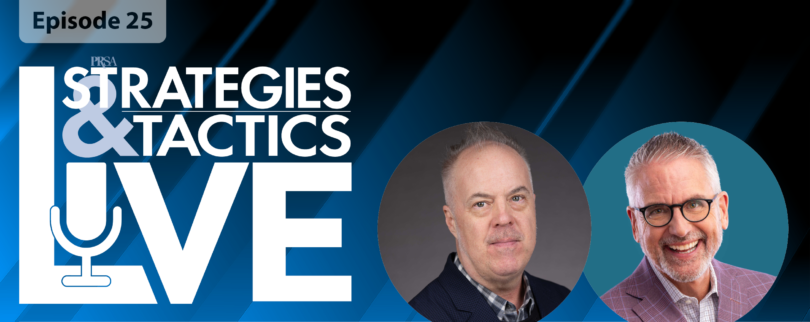Executive presence “is often more about how you’re perceived than what you do,” Rob Biesenbach said. “You look like you’ve got it together, like you know what you’re talking about.”
Biesenbach, a keynote speaker, workshop leader and author based in Chicago, joined Strategies & Tactics Live, PRSA’s monthly livestream on LinkedIn on Jan. 25.
In an era that values authenticity, John Elsasser, editor-in-chief of Strategies & Tactics and host of the webinar series, asked: Should aspiring leaders embrace their real strengths, rather than try to embody every type of leadership quality?
“When we’re real, we come across as being sincere,” said Biesenbach, whose Connect & Compel column runs in Strategies & Tactics. With a background in agency work, speechwriting and improv theater, he now coaches leaders to be storytellers in their speeches, presentations and meetings.
In his January column, Biesenbach proposed some New Year’s resolutions for budding leaders. Top of the list: Write a manifesto about your leadership values.
“Just start free-associating,” he suggested. “You can always edit it later.” Such brainstorming “becomes a process of figuring out who you are and what you’re about, everything that you believe. It could be about your subject of expertise, about life, relationships,” etc.
Once defined in your leadership manifesto, four or five core beliefs will guide you in any situation, said Biesenbach, who likened those points to key messages in public relations.
“You wouldn’t send a spokesperson out on a media tour without a handful of key messages,” he said. Your manifesto should convey what you’re about “in the workplace and out in the marketplace. These are the things that you communicate and demonstrate.”
In his own business manifesto, Biesenbach outlines his essential communications principles. Though familiar to PRSA readers, clients might not realize “that stories are often superior to data when it comes to persuasion,” he said. “You have to win hearts to change minds. Facts alone are not enough.”
Energy, passion, performance
“A presentation is often like a performance,” said Biesenbach, who was trained at the school of Chicago’s storied Second City theater. To connect with an audience, “You have to bring energy, exciting visuals and passion to the experience.”
In a meeting or presentation, passion might come through as “warmth and excitement,” depending on the nature of the message, he said. (It’s probably best not to appear passionate when announcing bad news, for example.)
To project executive presence, show “Conviction, strength, that you mean what you say and that you sound like you mean what you say.” When you’re in a meeting and have an idea to contribute, don’t hog the spotlight, but “Don’t second-guess yourself,” either. “Speak up.”
Crafting a personal story can give you a competitive edge in job interviews and promotions, Biesenbach said. But he knows it can be hard to stand outside of ourselves and to look at ourselves objectively.
“Telling our own stories is critical,” he said. “Whether you’re interviewing for a job, you meet someone at a networking event or you’re trying to get a promotion, nobody else has your specific story. That’s how you stand out from the competition. That’s how you get remembered.”
You can watch the playback on LinkedIn here.







